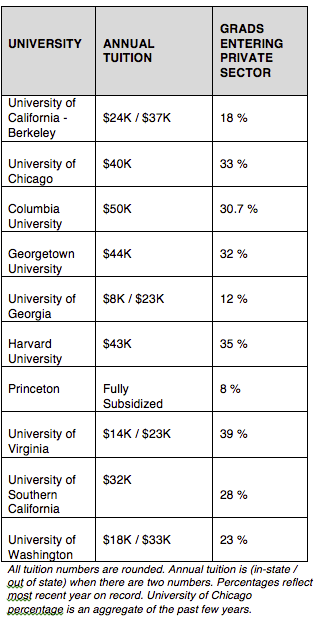
A Syracuse University logo is displayed inside the lobby of the Carmelo K. Anthony Basketball Center at Syracuse University in Syracuse, NY. (AP Photo/David Duprey)
A few weeks ago, the massive consulting firm Deloitte came to my public policy school – the Maxwell School at Syracuse University – to conduct what it called a “case challenge.” The students who participated were separated into groups and presented with a sample consulting challenge. At the end of the multi-day exercise, one team was declared the winner. After the case challenge concluded, the students were offered an opportunity to apply for a job at the firm – an incredibly early application, given that the Masters of Public Administration (MPA) students applying are in a one-year program that started last July and concludes in June 2014.
Deloitte’s heavy presence and early recruiting at the Maxwell School is ironic. After all, my school began not as a recruitment center for for-profit corporations like Deloitte but as a “school of American citizenship,” as its founder George Holmes Maxwell described it, with a primary goal of training Americans to work in government.
Deloitte does have government links. It rakes in billions of dollars from government contracts across the world. Its 2012 investor report shows $3.2 billion from work directly with the public sector.
Yet, while the government generously pays the firm to do work that many argue it should be doing itself, Deloitte has been repeatedly caught up in scandals of mismanagement and poor performance. For example, this past August, the state of Massachusetts fired Deloitte after having paid it $54 million to design a computer system that, by the time the contract was terminated, “couldn’t print forms or calculate interest and penalties,” both of which were functions specified in the contract.
Over the summer, the firm agreed to pay $10 million and suspend consulting work at financial institutions in New York following revelations that its consultants “hid details from regulators about Standard Chartered Bank’s transactions with Iranian clients.” Despite this involvement in facilitating money laundering, the firm ironically advertises “anti-money laundering consulting” on its website.
This behavior certainly isn’t what George Holmes Maxwell intended when he created a school of citizenship. But Deloitte is a for-profit firm, chiefly responsible to its investors, not to citizens or the government or various constituent groups such as nonprofits. The goal of its aggressive recruitment at my school and others is not to recruit civic-minded students to serve the public, but to bring on staff who will increase its bottom line.
In doing so, Deloitte and other commercial firms have been remarkably successful in recent years. In 2008, 10 percent of graduates who responded to the post-employment survey went to work in the private sector and 10 percent went to “public work in the private sector” – Maxwell’s terminology for consultants within the public sector. In last year’s class, the percentage of graduates who went to work in the private sector rose to 27 percent (the portion who did public work in the private sector remained at 10 percent). Meanwhile, graduates who went to work for the federal government declined from 25 percent in 2008 to 16 percent in 2012. Graduates who went to work for nonprofits plummeted from 29 to 14 percent.
It’s not only Maxwell that’s seen an increase in private sector employment among graduates, but a trend that has been consistent across multiple top public policy and administration graduate schools. [See below for a breakdown of post graduation jobs by university.] The trend mirrors the privatization of government overall and it’s happening at least partly as a result of the desire for greater compensation by for-profit firms, not because of well thought out social needs.
When graduates at my school and others are faced with massive loan payments and few recruitment opportunities from the public sector, their dreams of working for their local municipal government or the Department of Labor are quickly put aside when smiling recruiters from for-profit consulting firms appear promising high salaries. The moral qualms of working for companies that essentially do jobs the government should be doing itself – while paying executives literally 50 times what the president of the United States makes – fade away. Few students start their public affairs education dreaming of being for-profit consultants, but the nightmare of debt is a great motivator.
Post Graduate Job Trends by University
“At the [University of Chicago’s] Harris School, we have seen about a third of our graduates going into the private sector for many years,” says Leslie Andersen, associate director of the school’s career development office. “In the past few years, partly as a result of decreased government hiring, some students who might have gone to the public sector have found employment in the private sector working with consultants to the public sector, and we also have noted an increase in the number of students joining social enterprise/social entrepreneurial organizations, which are counted as private sector employers.”
The hiring decrease in the public sector is a phenomenon that may indeed be driving these trends. President Obama famously caught flack when he claimed that the “private sector is doing fine,” compared to the public sector, but the data backed him up. Mother Jones’ Kevin Drum pointed out that last year, the public sector was still shedding 200,000 jobs per year while the private sector was adding two million jobs per year.
Perhaps that shift partly explains hiring statistics at Columbia University’s School of International and Public Affairs (SIPA), where 30.7 percent of students went into the private sector – with private sector graduates earning a median salary of $80,000, a 45 percent higher salary than their public sector counterparts. Coupled with a 2013-2014 tuition of $49,788, it’s easy to see the allure of that compensation.
Although many top schools in the field have seen their graduates go to work for for-profit organizations instead of working in direct public service, recent data shows that nonprofits and government do continue to capture the most graduates when looking at the field as a whole. The Network of Schools of Public Policy, Affairs and Administration, which gives accreditation to public affairs schools, estimates that 18 percent of MPA/MPP graduates went to the private sector in 2012, while 27 percent went to work for nonprofits and 46 percent went to work for the government (although the private sector gained 3 percentage points from the previous year).
But some students, particularly at public schools, continue to trend towards the public and nonprofit sectors. For example, at the University of Georgia, only 12 percent of students from the class of 2012’s MPA program went private. “Approximately 80 percent of our students are pre-service and 20 percent are in-service. As to why we have a higher percentage that go into public service, I guess it is because we place a great emphasis on the value of public service in our program,” noted department head Dr. Edward Kellough. At the University of California-Berkeley, 18 percent of grads went to work in the private sector, versus 44 percent who went to work for local government. About two-thirds of graduates from the University of Washington’s MPP program went to work in the public or nonprofit sectors, as opposed to the third who took jobs in the private sector.
 Whatever the allure of the private sector to public policy program graduates, it is powerful at the University of Virginia. At the school’s Frank Batten School of Leadership and Public Policy, which began its accelerated Bachelors-to-Masters in Public Policy (MPP) program in 2007, the private sector has been strongly represented in the pool of those hiring graduates, taking 39 percent of them. Because the school is relatively new, it’s likely still establishing its alumni network and career office; consulting firms have swooped in to fill that void, with Bain & Co, Deloitte and PricewaterhouseCoopers all hiring MPP graduates.
Whatever the allure of the private sector to public policy program graduates, it is powerful at the University of Virginia. At the school’s Frank Batten School of Leadership and Public Policy, which began its accelerated Bachelors-to-Masters in Public Policy (MPP) program in 2007, the private sector has been strongly represented in the pool of those hiring graduates, taking 39 percent of them. Because the school is relatively new, it’s likely still establishing its alumni network and career office; consulting firms have swooped in to fill that void, with Bain & Co, Deloitte and PricewaterhouseCoopers all hiring MPP graduates.
For prestigious Georgetown University MPP graduates, the private sector was also well-represented among graduates’ jobs. The mean compensation for those who went to nonprofits was $65,090; for the public sector it was $68,858; for the private sector it was $75,107.
At the elite Harvard Kennedy School, 35 percent of reporting 2012 grads from its public policy and administration programs went to the private sector, capturing a plurality of students. The cost of attendance likely plays a large role in these graduates’ employment decisions. At Kennedy, for the 2013-2014 academic year, the school estimates a total cost (including tuition, fees, and room and board) of $72,302.
At Princeton University’s Woodrow Wilson School of Public Service, only eight percent of MPP graduates went to the private sector in 2013. One thing unique about Princeton’s program is that it offers generous aid and full scholarships to its students, an advantage over most other schools. “An important component… is that students graduate debt-free, so they can make decisions about where to work based on what they want to do, not what they have to pay back in loans,” notes Elisabeth Donahue, the associate dean for public and external affairs at the Woodrow Wilson School.
Whether this trend towards private sector employment continues depends on a number of factors. Will the public sector recover and recruit as aggressively at schools as the big consulting firms? Will skyrocketing tuition costs be reined in? Will students themselves rebel against the trend and aggressively seek employment in the government or at nonprofits?
If the trend does not reverse, or worse, accelerates, we may see a mini-version of what happened on Wall Street in the past few decades – a massive shift of talented college grads landing in a for-profit industry that creates tenuous benefits for the country, while government offices and nonprofit organizations are denied some of the country’s top talent. It would effectively be a privatization of public service – something that would likely have made George Holmes Maxwell shudder.


